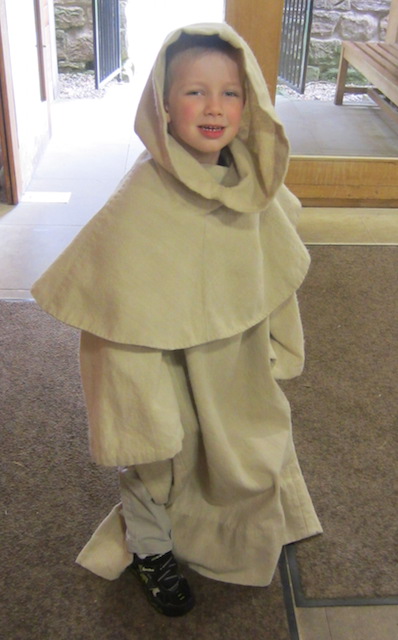Fountains Abbey was united to the Studley Royal estate in 1767 when William Aislabie (owner of Studley Royal) was able to purchase the abbey ruins and Fountains Hall for eighteen thousand pounds. He began making improvements so visitors could come and he built ritzy gardens from the ruins to his home. We explored some of the gardens on one of our visits to the abbey.
We started in the Porters Lodge, which originally served as a gateway for visitors to the abbey. The small museum has displays about life at the abbey and some dress up activities for the children.
We followed a path down the River Skell. The river is peaceful, lined with some amazing trees along the way.
We aw a bit of the 18th century gardens, including a statue of Hercules fighting the giant Antaeus. Since the giant gained strength from standing on the ground, Hercules lifted him off the ground to crush him to death.
Nearby is a small artificial cave called the Grotto. J enjoyed hiding in there.
A path near the Grotto leads up the hill to the High Ride, a path along a ridge overlooking the estate. A small shelter for looking down on the river and the abbey ruins is called Anne Boleyn's Seat. The name comes from a nickname for an old, headless Roman statue of a woman that stands nearby.
The hillside had plenty of stumps and critters for the kids to enjoy. The gardeners constantly maintain the trees and shrubs to ensure a good view, so it may be different by now.
On our way out we spotted a Victorian-era post box. You can tell it's from Queen Victoria's times because of the "VR" at the top which stands for "Victoria Regina" in Latin which translates as "Queen Victoria."
We started in the Porters Lodge, which originally served as a gateway for visitors to the abbey. The small museum has displays about life at the abbey and some dress up activities for the children.
 |
| J checks out the archeological finds |
 |
| J the monk |
 |
| L lost in her habit |
 |
| A model of the abbey in its heyday |
We followed a path down the River Skell. The river is peaceful, lined with some amazing trees along the way.
 |
| Leaving the abbey behind |
 |
| The trail by the river |
 |
| View of the river |
 |
| Cool tree roots |
 |
| One of the lakes |
We aw a bit of the 18th century gardens, including a statue of Hercules fighting the giant Antaeus. Since the giant gained strength from standing on the ground, Hercules lifted him off the ground to crush him to death.
 |
| 1700s-era gardens |
 |
| Hercules vs. Antaeus |
Nearby is a small artificial cave called the Grotto. J enjoyed hiding in there.
 |
| The Grotto |
A path near the Grotto leads up the hill to the High Ride, a path along a ridge overlooking the estate. A small shelter for looking down on the river and the abbey ruins is called Anne Boleyn's Seat. The name comes from a nickname for an old, headless Roman statue of a woman that stands nearby.
 |
| J enjoys the view |
 |
| "Anne Boleyn" statue |
 |
| 3/4 view of the statue |
The hillside had plenty of stumps and critters for the kids to enjoy. The gardeners constantly maintain the trees and shrubs to ensure a good view, so it may be different by now.
 |
| Rooting for the trees |
 |
| J and L and an over-sized stump |
 |
| Another cool stump |
 |
| A furry friend |
 |
| Another nice view from the High Ride |
On our way out we spotted a Victorian-era post box. You can tell it's from Queen Victoria's times because of the "VR" at the top which stands for "Victoria Regina" in Latin which translates as "Queen Victoria."
 |
| Victorian mailbox in a stone wall |



No comments:
Post a Comment